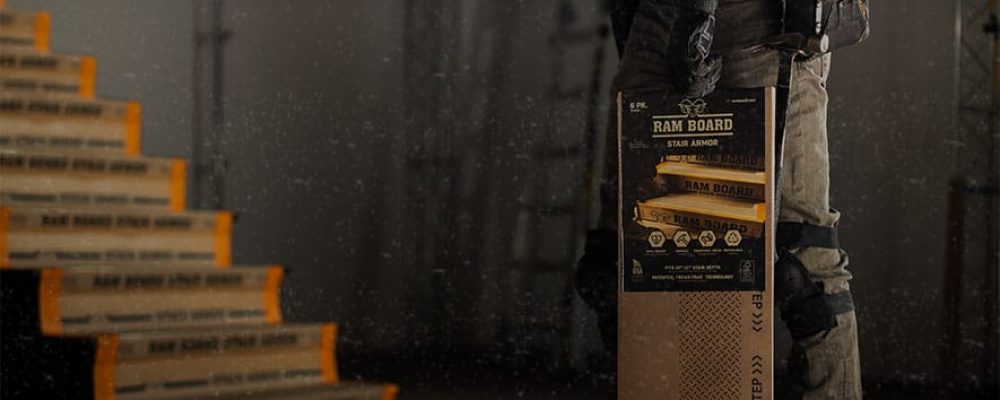WHAT IS STAIR PROTECTION AND WHY IS IT IMPORTANT?
If you’re about to start a construction, renovation, or home improvement project, one thing you have to think about is how to protect your stairs in high-traffic areas from damage while you work. You don’t want to find out the hard way how much time and money it can cost you to repair damaged stairs. It doesn’t matter if you’re protecting carpeted or hardwood stairs, or on a construction site with concrete flooring, damage to surfaces can ruin your day quickly.
Temporary stair protection is a product that goes over stairs during a job, whether it’s a construction, painting, or remodeling project. Stair protection not only keeps the surface safe from damage, but it can also provide a safer working environment since many products also have non-slip qualities. This makes protective floor coverings for stairs an important part of the jobsite protection process.

WHAT IS STAIR PROTECTION AND WHY IS IT IMPORTANT?
If you’re about to start a construction, renovation, or home improvement project, one thing you have to think about is how to protect your stairs in high-traffic areas from damage while you work. You don’t want to find out the hard way how much time and money it can cost you to repair damaged stairs. It doesn’t matter if you’re protecting carpeted or hardwood stairs, or on a construction site with concrete flooring, damage to surfaces can ruin your day quickly.
Temporary stair protection is a product that goes over stairs during a job, whether it’s a construction, painting, or remodeling project. Stair protection not only keeps the surface safe from damage, but it can also provide a safer working environment since many products also have non-slip qualities. This makes protective floor coverings for stairs an important part of the jobsite protection process.
3 steps to protect your stairs during construction and renovation projects
Taking some time before you start your project to prep your jobsite with surface protectioncan help you avoid some major headaches down the road. We’ve put together a few tips for protecting stairs during construction, so you can get the job done right.
1. Choose your stair protection
Choosing the right temporary surface protection for the job starts with figuring out what type is best for the floors on your jobsite.
Carpeted stairs – Whether you’re painting or renovating, carpet protection on stairs is important. Make sure to cover carpeted stairs while you work. Carpet is easily damaged from paint spills, mud, and other tracked in debris. You can use slip-resistant drop cloths and runners as well as carpet film to easily protect carpeted stairs during construction.
Hardwood stairs – Hardwood stairs can be easily scratched, but they can just as easily be protected. The key to making sure that hardwood floors don’t get scratched while you work is to clean them before you install the heavy-duty stair protection. That way trapped debris can’t damage the surface.
Cardboard is often used to protect stairs, but there are easier options in the market. Products like our very own Stair Armor are precut to fit stairs and are shaped to cover the rise, bull nose, and tread.
Concrete and other hard surfaces – You may think hard surfaces like concretestairs don’t need protection, but when you’re carrying equipment up and down, it’s important to have a surface protective covering that shields the stairs from impacts.
Using a product like Stair Armor is ideal because, like our bestseller Ram Board, it is breathable, spill-resistant, and non-staining. The grip strip backing holds it in place while also absorbing impacts.
2. Prep your surfaces
Like we said before, the most important thing you can do before installing your stair protection is to clean your surfaces! We cannot emphasize it enough, if dirt or debris is trapped beneath your drop cloth or surface protection board it can gouge, scratch, or otherwise damage your stairs.
When prepping, make sure to wipe down or vacuum your stairs thoroughly. This will also help your tape adhere better if you are using a temporary stair protector that needs to be taped down.
3. Install the temporary stair protection

Apply carpet protection film easily by adhering the end to the top or bottom of the stairs and unrolling and adhering as you go. Make sure to check the longevity of your film before applying. Many manufacturers suggest no longer than 30 days to prevent damage.
Stair Armor can be installed by placing the board over the stair tread. Use the adjustable fold to cover the bullnose and tape the edges directly to the stairs with an adhesive tape that won’t leave residue (we suggest Ram Board 90 Day Edge Tape). Repeat the process and tape the sheets of Stair Armor together to completely cover the stairs.
Once your stair protection for construction and renovation is in place – and your other surfaces and floors covered to protect them from damage – you’re ready to get to work.
Protect Your Stairs from Construction to Avoid Costly Repairs
Protecting stairs during construction and renovation projects is an easy way to avoid the headaches and hassle of repairing any damage. Here at Ram Board, we understand the importance of jobsite protection. From wall and floor protection, to door jamb protection, stair protection and more, Ram Board has you covered. Check out our full line of products by visiting our catalog.
